LOTUS ELISE 2005 User Guide
Manufacturer: LOTUS, Model Year: 2005, Model line: ELISE, Model: LOTUS ELISE 2005Pages: 205, PDF Size: 4.51 MB
Page 11 of 205
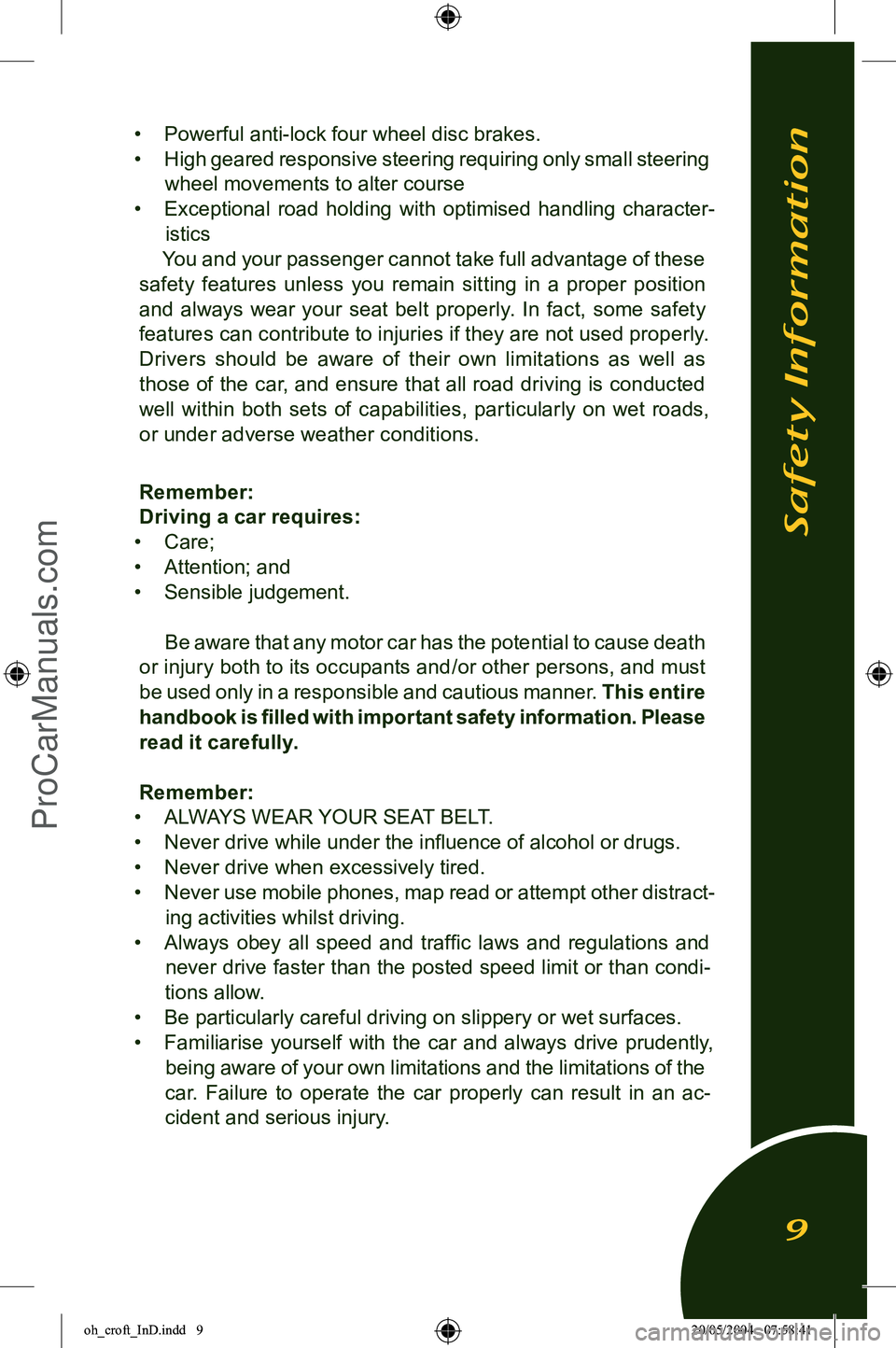
• Powerful anti-lock four wheel disc brakes.
• High geared responsive steering requiring only small steering
wheel movements to alter course
• Exceptional road holding with optimised handling character
-
istics
You and your passenger cannot take full advantage of these
safety features unless you remain sitting in a proper position
and always wear your seat belt properly. In fact, some safety
features can contribute to injuries if they are not used properly. Drivers should be aware of their own limitations as well as
those of the car, and ensure that all road driving is conducted
well within both sets of capabilities, particularly on wet roads, or under adverse weather conditions.
Remember:
Driving a car requires:
• Care;
• Attention; and
• Sensible judgement.
Be aware that any motor car has the potential to cause death
or injury both to its occupants and/or other persons, and must
be used only in a responsible and cautious manner. This entire
handbook is filled with important safety information.
Please
read it carefully.
Remember:
• ALWAYS WEAR YOUR SEAT BELT.
• Never drive while under the influence of alcohol or drugs.
• Never drive when excessively tired.
• Never use mobile phones, map read or attempt other distract
-
ing activities whilst driving.
• Always obey all speed and traffic laws and regulations and never drive faster than the posted speed limit or than condi
-
tions allow.
• Be particularly careful driving on slippery or wet surfaces.
• Familiarise yourself with the car and always drive prudently, being aware of your own limitations and the limitations of the
car. Failure to operate the car properly can result in an ac
-
cident and serious injury.
Safety Information
9
oh_croft_InD.indd 920/05/2004 07:58:41ProCarManuals.com
Page 12 of 205
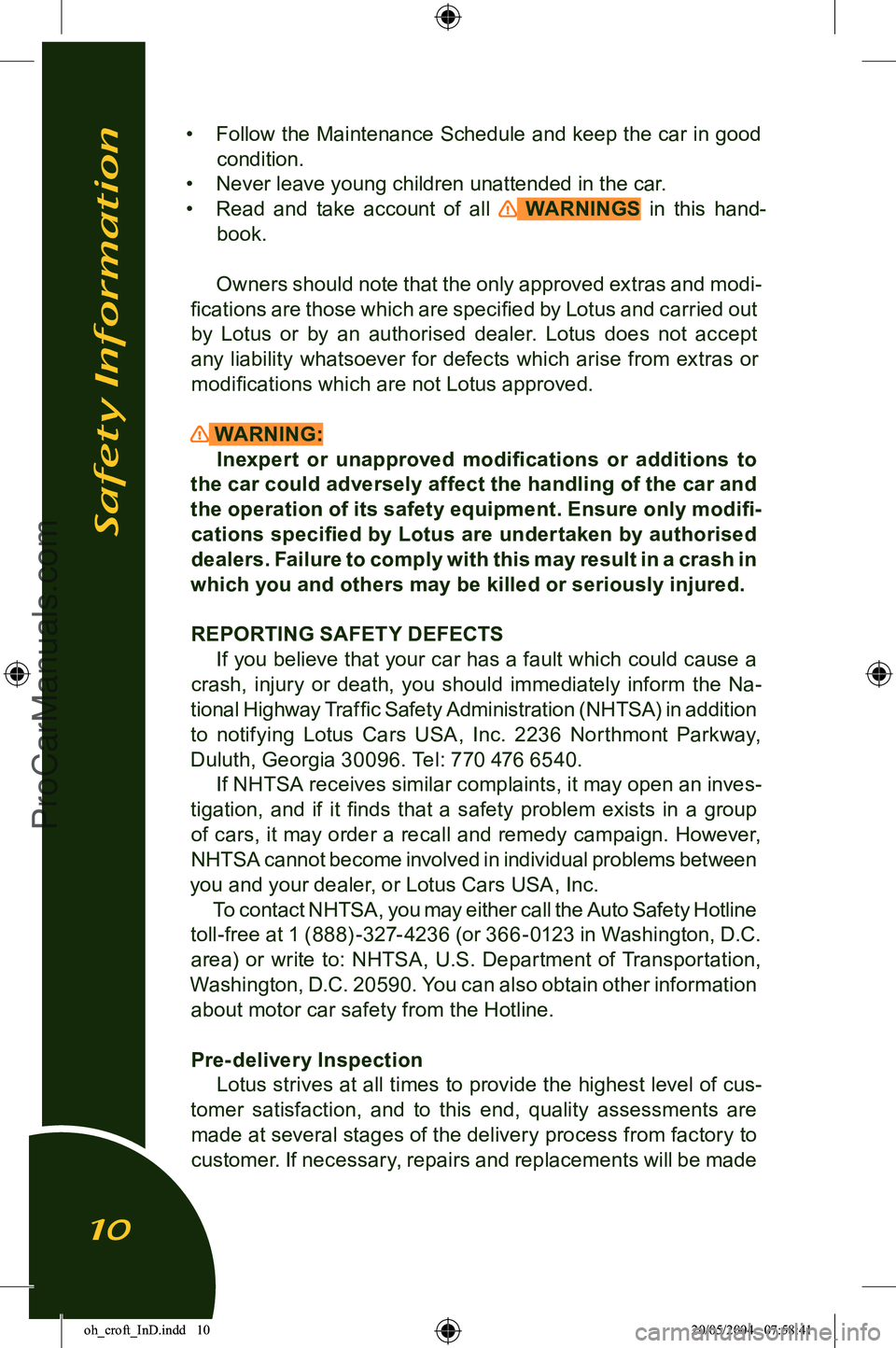
• Follow the Maintenance Schedule and keep the car in good
condition.
• Never leave young children unattended in the car.
• Read and take account of all
WARNINGS in this hand-
book.
Owners should note that the only approved extras and modi
-
fications are those which are specified by Lotus and carried out by Lotus or by an authorised dealer. Lotus does not accept
any liability whatsoever for defects which arise from extras or modifications which are not Lotus approved.
WARNING: Inexpert or unapproved modifications or additions to
the car could adversely affect the handling of the car and
the operation of its safety equipment. Ensure only modifi
-
cations specified by Lotus are undertaken by authorised
dealers. Failure to comply with this may result in a crash in
which you and others may be killed or seriously injured.
REPORTING SAFETY DEFECTS If you believe that your car has a fault which could cause a
crash, injury or death, you should immediately inform the Na
-
tional Highway Traffic Safety Administration (NHTSA) in addition
to notifying Lotus Cars USA, Inc. 2236 Northmont Parkway,
Duluth, Georgia 30096. Tel: 770 476 6540. If NHTSA receives similar complaints, it may open an inves
-
tigation, and if it finds that a safety problem exists in a group of cars, it may order a recall and remedy campaign. However,
NHTSA cannot become involved in individual problems between
you and your dealer, or Lotus Cars USA, Inc. To contact NHTSA, you may either call the Auto Safety Hotline
toll-free at 1 (888) -327- 4236 (or 366- 0123 in Washington, D.C.
area) or write to: NHTSA, U.S. Department of Transportation,
Washington, D.C. 20590. You can also obtain other information about motor car safety from the Hotline.
Pre- delivery Inspection Lotus strives at all times to provide the highest level of cus
-
tomer satisfaction, and to this end, quality assessments are made at several stages of the delivery process from factory to
customer. If necessary, repairs and replacements will be made
Safety Information
10
oh_croft_InD.indd 1020/05/2004 07:58:41ProCarManuals.com
Page 13 of 205
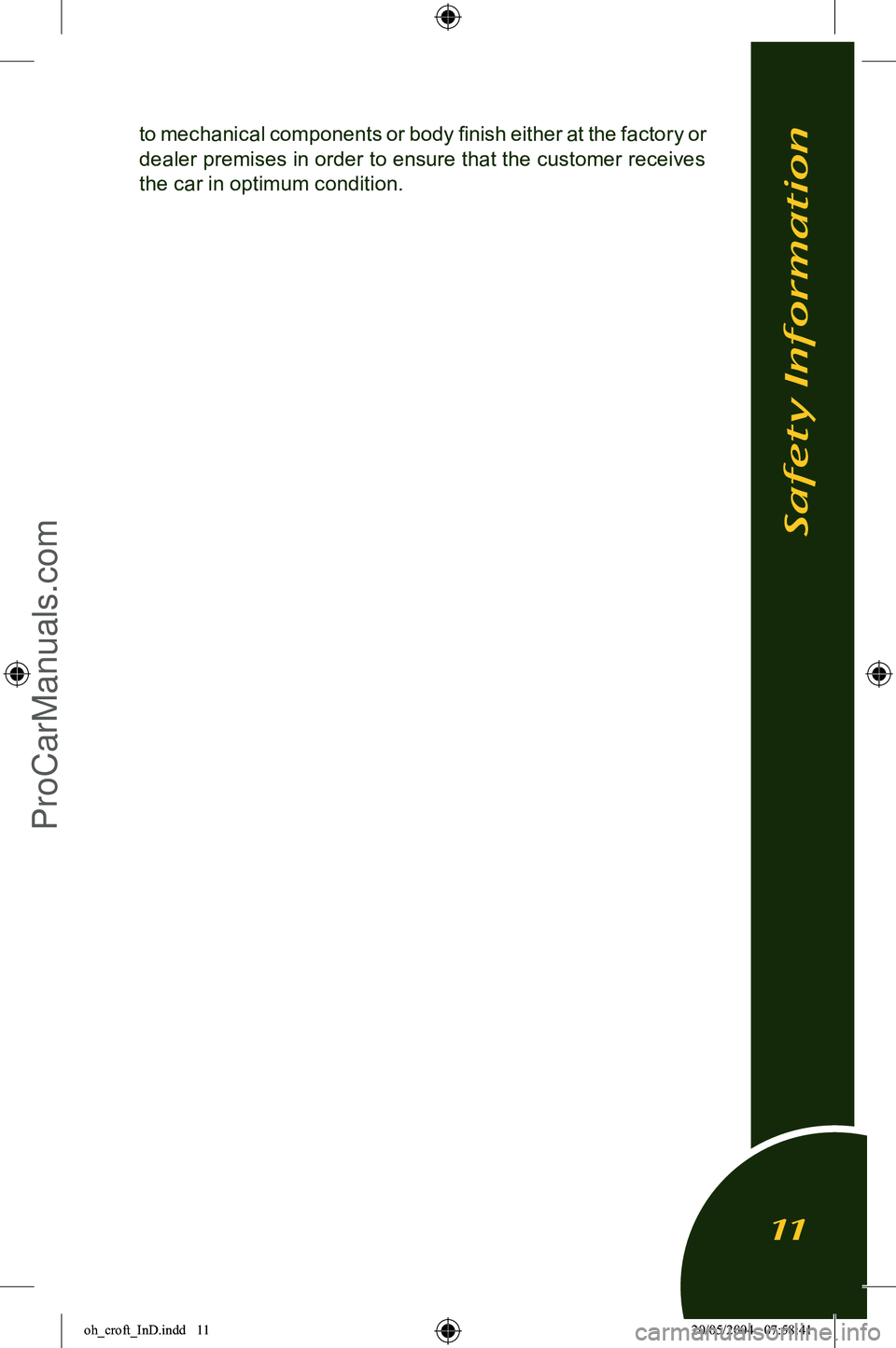
to mechanical components or body finish either at the factory or dealer premises in order to ensure that the customer receives
the car in optimum condition.
Safety Information
11
oh_croft_InD.indd 1120/05/2004 07:58:41ProCarManuals.com
Page 14 of 205
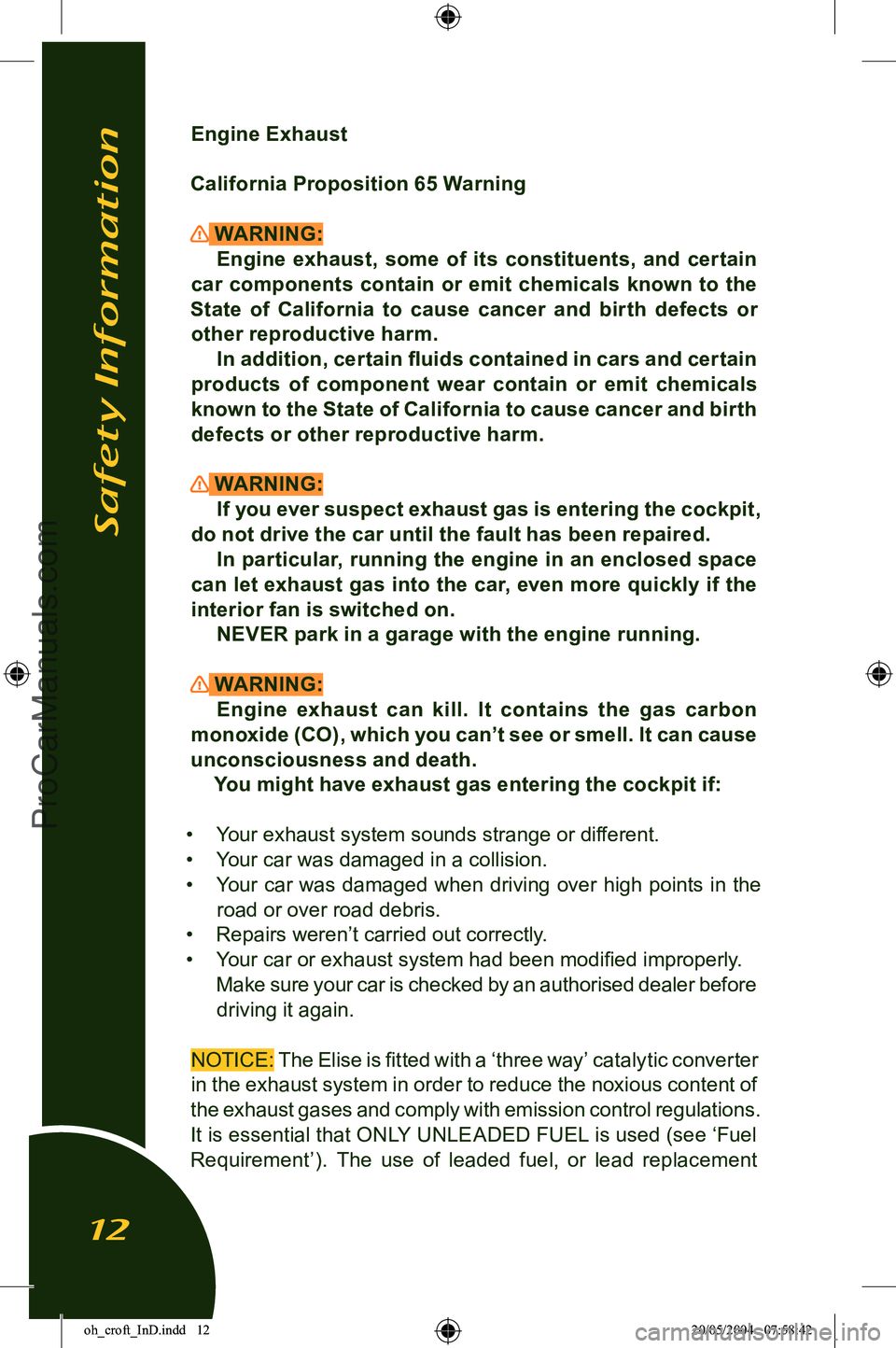
Engine Exhaust
California Proposition 65 Warning
WARNING: Engine exhaust, some of its constituents, and certain
car components contain or emit chemicals known to the
State of California to cause cancer and birth defects or other reproductive harm. In addition, certain fluids contained in cars and certain
products of component wear contain or emit chemicals
known to the State of California to cause cancer and birth
defects or other reproductive harm.
WARNING: If you ever suspect exhaust gas is entering the cockpit,
do not drive the car until the fault has been repaired.
In particular, running the engine in an enclosed space
can let exhaust gas into the car, even more quickly if the interior fan is switched on. NEVER park in a garage with the engine running.
WARNING:Engine exhaust can kill. It contains the gas carbon
monoxide (CO), which you can’t see or smell. It can cause
unconsciousness and death. You might have exhaust gas entering the cockpit if:
• Your exhaust system sounds strange or different.
• Your car was damaged in a collision.
• Your car was damaged when driving over high points in the
road or over road debris.
• Repairs weren’t carried out correctly.
• Your car or exhaust system had been modified improperly.
Make sure your car is checked by an authorised dealer before
driving it again.
NOTICE: The Elise is fitted with a ‘three way’ catalytic converter
in the exhaust system in order to reduce the noxious content of
the exhaust gases and comply with emission control regulations.
It is essential that ONLY UNLEADED FUEL is used (see ‘Fuel Requirement’). The use of leaded fuel, or lead replacement
Safety Information
12
oh_croft_InD.indd 1220/05/2004 07:58:42ProCarManuals.com
Page 15 of 205
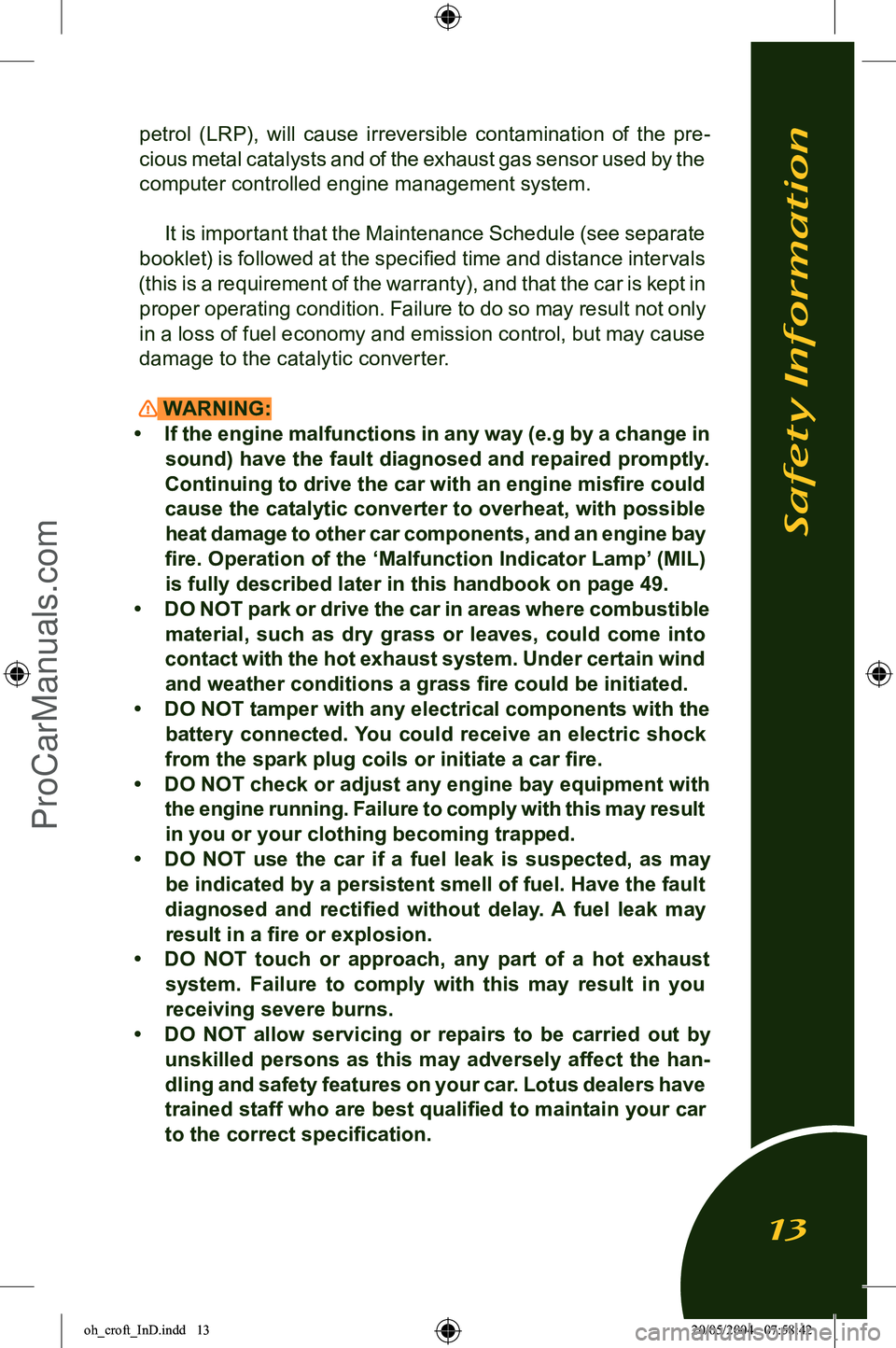
petrol (LRP), will cause irreversible contamination of the pre-
cious metal catalysts and of the exhaust gas sensor used by the
computer controlled engine management system.
It is important that the Maintenance Schedule (see separate
booklet) is followed at the specified time and distance intervals
(this is a requirement of the warranty), and that the car is kept in proper operating condition. Failure to do so may result not only
in a loss of fuel economy and emission control, but may cause damage to the catalytic converter.
WARNING:
• If the engine malfunctions in any way (e.g by a change in sound) have the fault diagnosed and repaired promptly.
Continuing to drive the car with an engine misfire could cause the catalytic converter to overheat, with possible heat damage to other car components, and an engine bay
fire. Operation of the ‘Malfunction Indicator Lamp’ (MIL)
is fully described later in this handbook on page 49.
• DO NOT park or drive the car in areas where combustible material, such as dry grass or leaves, could come into
contact with the hot exhaust system. Under certain wind and weather conditions a grass fire could be initiated.
• DO NOT tamper with any electrical components with the battery connected. You could receive an electric shock
from the spark plug coils or initiate a car fire.
• DO NOT check or adjust any engine bay equipment with the engine running. Failure to comply with this may result
in you or your clothing becoming trapped.
• DO NOT use the car if a fuel leak is suspected, as may be indicated by a persistent smell of fuel. Have the fault
diagnosed and rectified without delay. A fuel leak may result in a fire or explosion.
• DO NOT touch or approach, any part of a hot exhaust
system. Failure to comply with this may result in you
receiving severe burns.
• DO NOT allow servicing or repairs to be carried out by unskilled persons as this may adversely affect the han
-
dling and safety features on your car. Lotus dealers have
trained staff who are best qualified to maintain your car
to the correct specification.
Safety Information
13
oh_croft_InD.indd 1320/05/2004 07:58:42ProCarManuals.com
Page 16 of 205
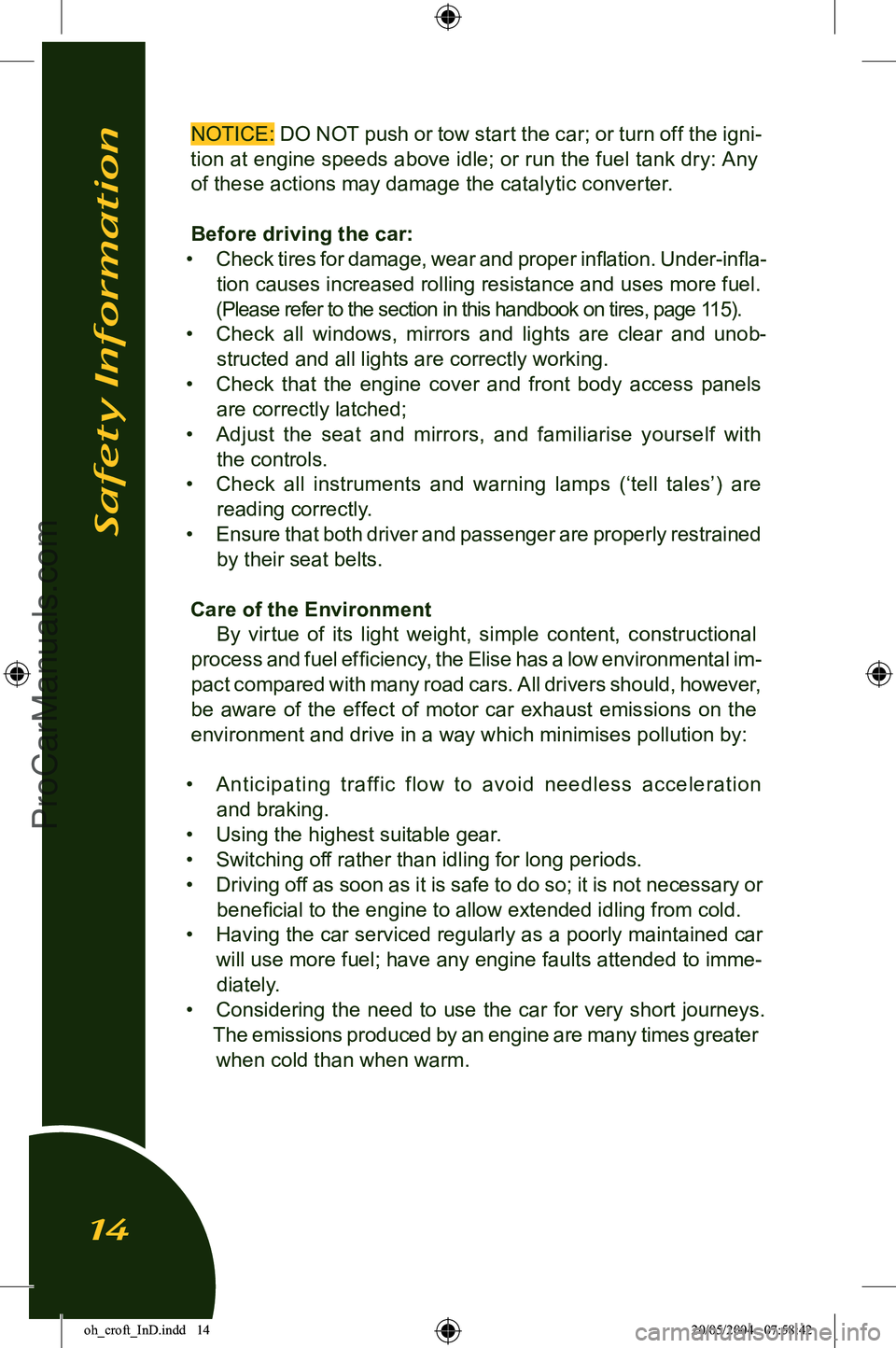
NOTICE: DO NOT push or tow start the car; or turn off the igni-
tion at engine speeds above idle; or run the fuel tank dry: Any of these actions may damage the catalytic converter.
Before driving the car:
• Check tires for damage, wear and proper inflation.
Under-infla-
tion causes increased rolling resistance and uses more fuel.
(Please refer to the section in this handbook on tires, page 115).
• Check all windows, mirrors and lights are clear and unob
-
structed and all lights are correctly working.
• Check that the engine cover and front body access panels
are correctly latched;
• Adjust the seat and mirrors, and familiarise yourself with
the controls.
• Check all instruments and warning lamps (‘tell tales’) are reading correctly.
• Ensure that both driver and passenger are properly restrained
by their seat belts.
Care of the Environment By virtue of its light weight, simple content, constructional
process and fuel efficiency, the Elise has a low environmental im
-
pact compared with many road cars. All drivers should, however,
be aware of the effect of motor car exhaust emissions on the
environment and drive in a way which minimises pollution by:
• Anticipating traffic flow to avoid needless acceleration
and braking.
• Using the highest suitable gear.
• Switching off rather than idling for long periods.
• Driving off as soon as it is safe to do so; it is not necessary or beneficial to the engine to allow extended idling from cold.
• Having the car serviced regularly as a poorly maintained car will use more fuel; have any engine faults attended to imme
-
diately.
• Considering the need to use the car for very short journeys.
The emissions produced by an engine are many times greater
when cold than when warm.
Safety Information
14
oh_croft_InD.indd 1420/05/2004 07:58:42ProCarManuals.com
Page 17 of 205
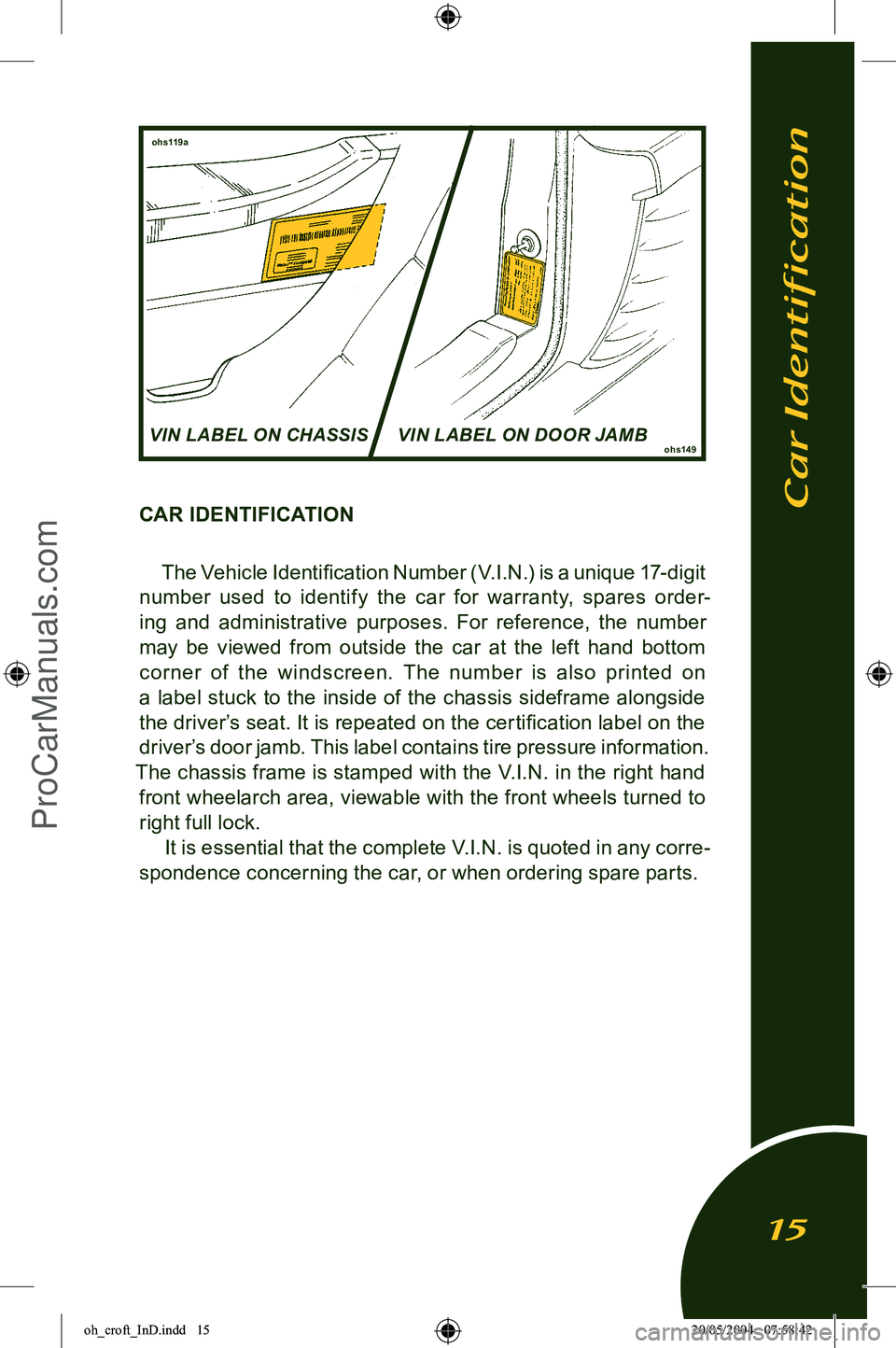
CAR IDENTIFICATIONThe Vehicle Identification Number (V.I.N.) is a unique 17-digit
number used to identify the car for warranty, spares order
-
ing and administrative purposes. For reference, the number may be viewed from outside the car at the left hand bottom
corner of the windscreen. The number is also printed on
a label stuck to the inside of the chassis sideframe alongside
the driver’s seat. It is repeated on the certification label on the
driver’s door jamb. This label contains tire pressure information.
The chassis frame is stamped with the V.I.N. in the right hand front wheelarch area, viewable with the front wheels turned to right full lock.
It is essential that the complete V.I.N. is quoted in any corre
-
spondence concerning the car, or when ordering spare parts.
VIN LABEL ON DOOR JAMB VIN LABEL ON CHASSIS
Car Identification
15
ohs119a
ohs149
oh_croft_InD.indd 1520/05/2004 07:58:42ProCarManuals.com
Page 18 of 205
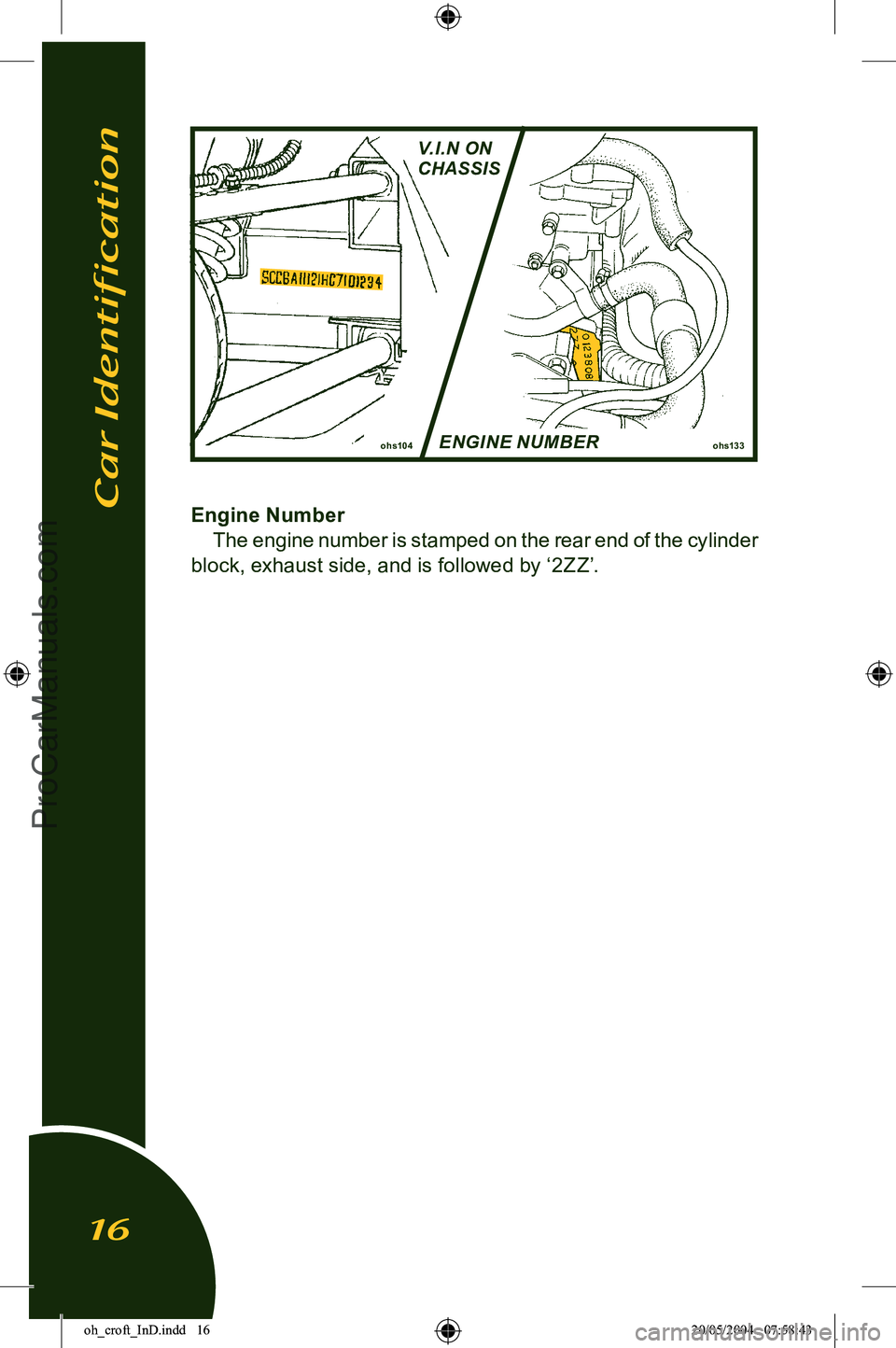
Engine NumberThe engine number is stamped on the rear end of the cylinder
block, exhaust side, and is followed by ‘2ZZ’.
ohs133ohs104
Car Identification
16
ENGINE NUMBER
V.I.N ON
CHASSIS
oh_croft_InD.indd 1620/05/2004 07:58:43ProCarManuals.com
Page 19 of 205
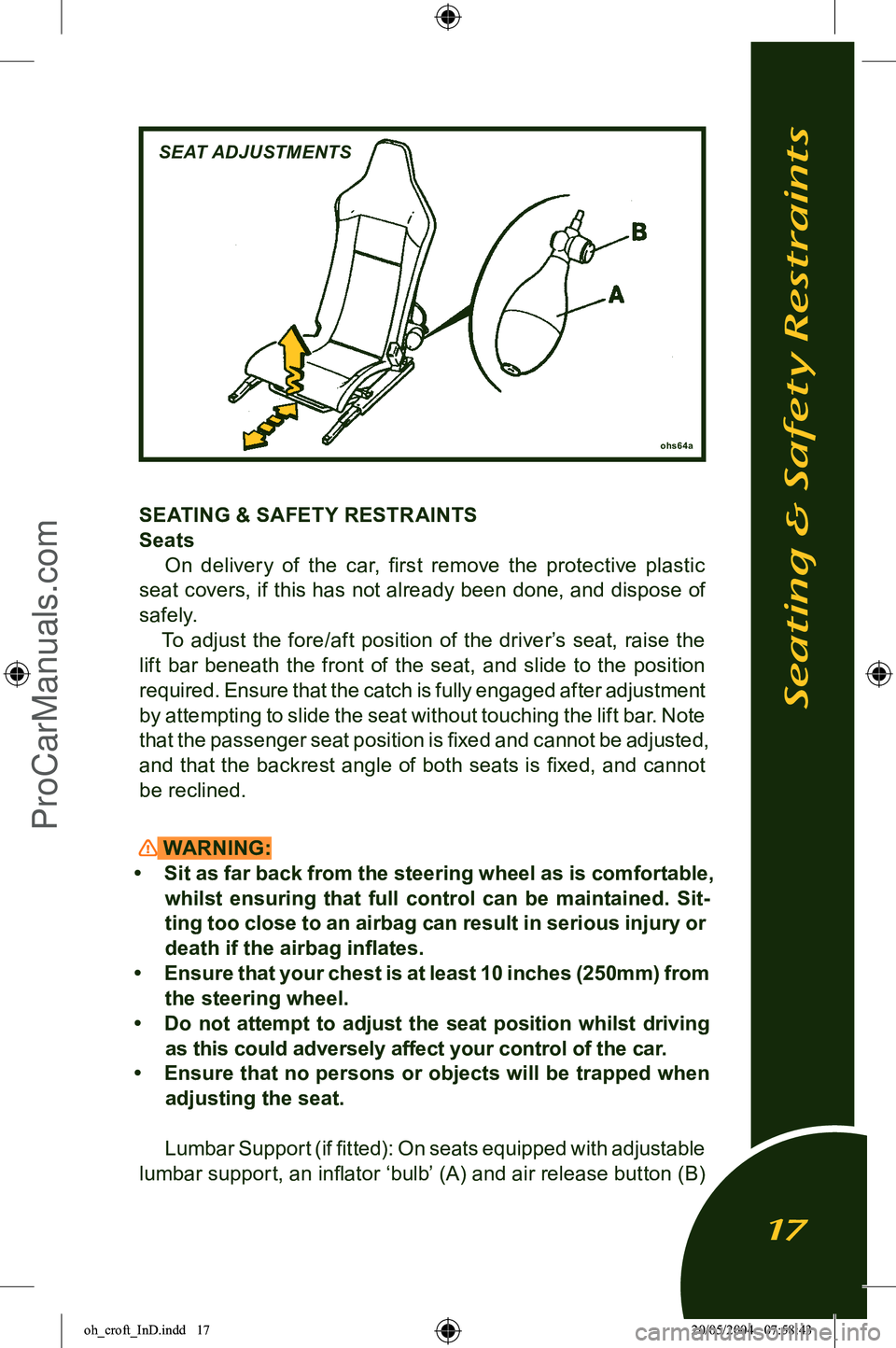
SEATING & SAFETY RESTRAINTS
SeatsOn delivery of the car, first remove the protective plastic
seat covers, if this has not already been done, and dispose of
safely. To adjust the fore/aft position of the driver’s seat, raise the
lift bar beneath the front of the seat, and slide to the position
required. Ensure that the catch is fully engaged after adjustment
by attempting to slide the seat without touching the lift bar. Note
that the passenger seat position is fixed and cannot be adjusted, and that the backrest angle of both seats is fixed, and cannot be reclined.
WARNING:
• Sit as far back from the steering wheel as is comfortable, whilst ensuring that full control can be maintained. Sit
-
ting too close to an airbag can result in serious injury or death if the airbag inflates.
• Ensure that your chest is at least 10 inches (250mm) from
the steering wheel.
• Do not attempt to adjust the seat position whilst driving as this could adversely affect your control of the car.
• Ensure that no persons or objects will be trapped when adjusting the seat.
Lumbar Support (if fitted): On seats equipped with adjustable
lumbar support, an inflator ‘bulb’ (A) and air release button (B)
ohs64a
SEAT ADJUSTMENTS
Seating & Safety Restraints
17
oh_croft_InD.indd 1720/05/2004 07:58:43ProCarManuals.com
Page 20 of 205
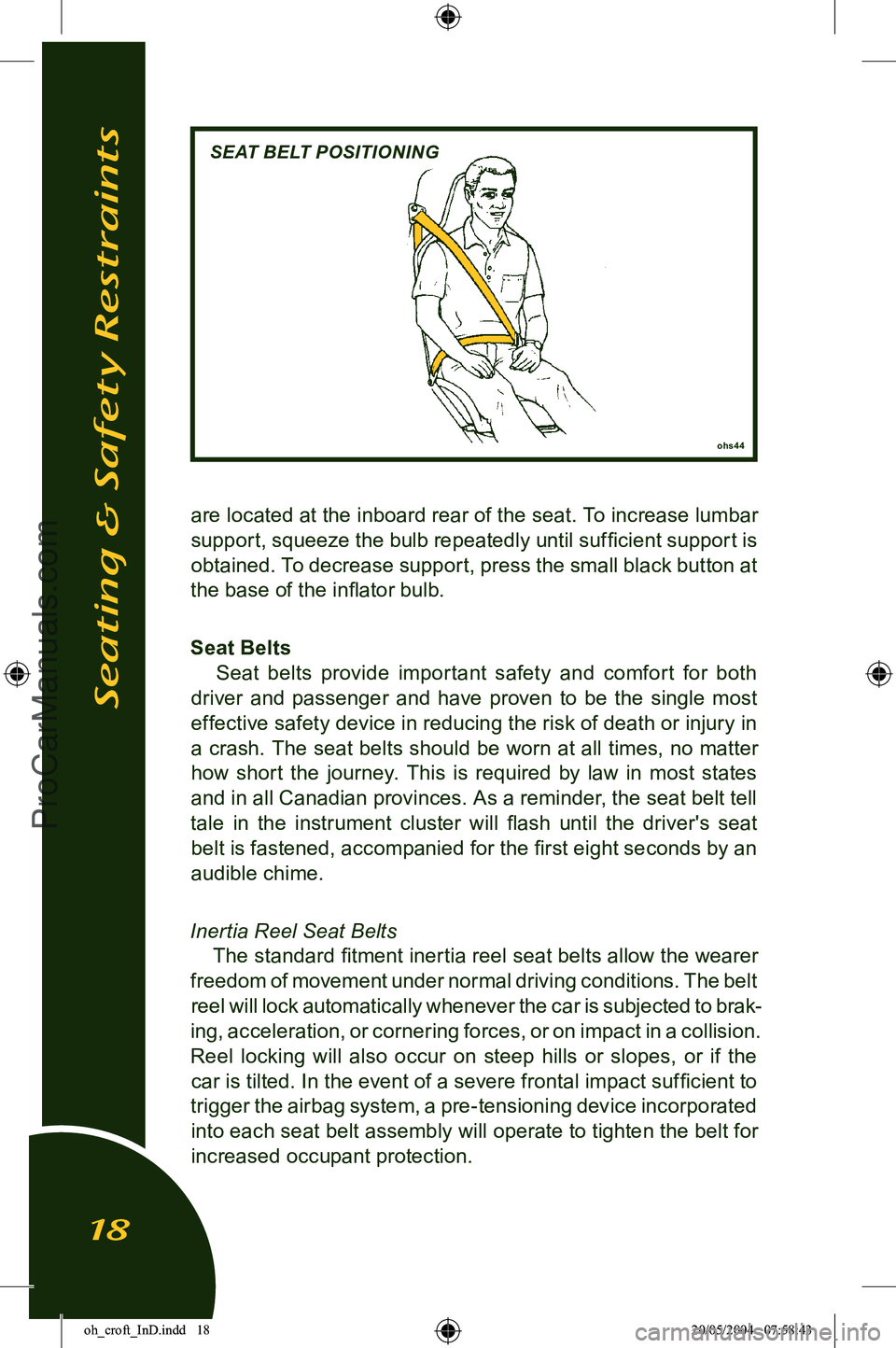
are located at the inboard rear of the seat. To increase lumbar
support, squeeze the bulb repeatedly until sufficient support is obtained. To decrease support, press the small black button at
the base of the inflator bulb.
Seat Belts Seat belts provide important safety and comfort for both
driver and passenger and have proven to be the single most
effective safety device in reducing the risk of death or injury in
a crash. The seat belts should be worn at all times, no matter how short the journey. This is required by law in most states
and in all Canadian provinces. As a reminder, the seat belt tell
tale in the instrument cluster will flash until the driver's seat
belt is fastened, accompanied for the first eight seconds by an
audible chime.
Inertia Reel Seat Belts The standard fitment inertia reel seat belts allow the wearer
freedom of movement under normal driving conditions. The belt reel will lock automatically whenever the car is subjected to brak
-
ing, acceleration, or cornering forces, or on impact in a collision. Reel locking will also occur on steep hills or slopes, or if the
car is tilted. In the event of a severe frontal impact sufficient to
trigger the airbag system, a pre-tensioning device incorporated into each seat belt assembly will operate to tighten the belt for
increased occupant protection.
ohs44
SEAT BELT POSITIONING
Seating & Safety Restraints
18
oh_croft_InD.indd 1820/05/2004 07:58:43ProCarManuals.com